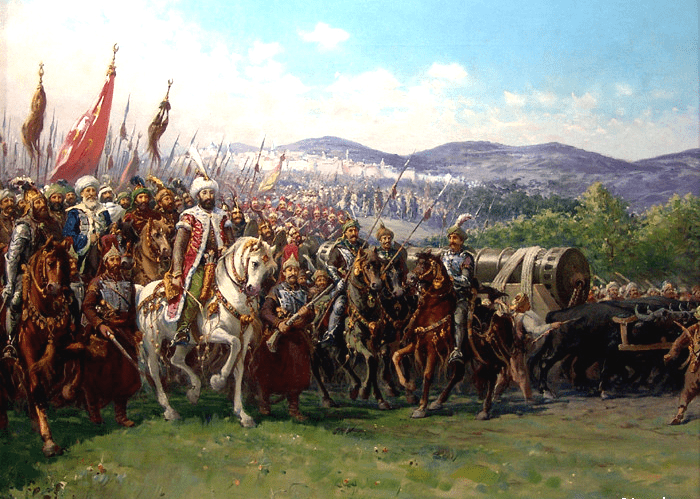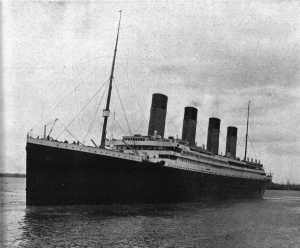How do you beat a good defense? By having a better offense. In the year 1453, one of the greatest showcases of artillery advancement in history took place. There were two groups in conflict, each known for a strength opposite the other: one was known for its indestructible defensive walls, and the other known for its weapons of assault. These two sides were the Byzantines and the Ottomans. The event bringing them together was siege of the Byzantine capital Constantinople. The aftermath of this siege was the recognition of the Ottomans as a new major power in the world. Their victory over the Byzantine Empire, heir to the ancient Roman Empire, marked the waning of the Middle Ages and the early dawning of a new age to come, the Early Modern era.

Mehmed II was the ruler of the Ottoman people when he seized control of the Byzantine Empire. At age eighteen, when he first got power, there was a backlash within the ranks of his commanders. Mehmed II was forced out of power. His father, Mehmed I, had to help his son regain his power. This event fueled Mehmed II’s sense of conquering, having been betrayed by his own people for power.1 The Ottoman army was known as one of the first groups to use gunpowder. In their military attacks, it was a clash of great defense versus a great offense. At the age of twenty-one, Mehmed II lead a military attack against the Byzantine Empire with a weapon known as the Orban cannon, the biggest cannon ever seen in the medieval world. The measurements of this unique cannon were about 27 feet long. It was walled with 8 inches of solid bronze and had a diameter of 30 inches. The target was the unbreakable walls of Constantinople, which the maker of the cannon had had a great deal of time studying. Constantinople was the yet-unconquered capital, and for over a thousand years it had only been captured once, in 1204. The Ottomans saw it as a perfect capital for the empire they hoped to rule. The walls, however, posed a great problem for any foreign invader, because of their height and depth. Therefore, Mehmed II had this special cannon built. The rest of the Byzantine Empire had already been conquered by the Ottomans, and Constantinople was the last remaining piece to be taken.2
The architect behind the destructive cannon was a man named Orban. There is not much information on his earlier life. We have very little information about him regarding the creation of his cannons. Orban was a Hungarian cannon maker. He was opportunistic. No matter who employed him, he just wanted to create the next big cannon. He first began his campaign at the unconquered city of Constantinople, stopping there to sell his services and ideas to Emperor Constantine XI. He liked Orban’s idea for a super-weapon cannon, but he was not willing to offer him much funding for the project. Growing frustrated with Constantine’s financial support, Orban decided to go to the opposing force in the war. He went to see Mehmed II and offer him his services. When the two met, “Mehmed asked Orban if he could cast a cannon large enough to smash the walls of Constantinople.” Orban replied with “I can cast a cannon of bronze with the capacity of the stone you want. I have examined the walls of the city in great detail. I can shatter to dust not only these walls with the stones from my gun, but the very walls of Babylon.”3 Orban proceeded to work on the cannons, and once he was finished, Mehmed ordered a test shot in front of his palace. The test was amazing. The cannon shot its projectile over a mile. The fear it then would strike into the opponent’s hearts was incomparable to anything known. The sheer power of the weapon was terrifying.

With the final product finished, the hard part began: the transportation of the cannon for a trip of 140 miles to the destination. The moving team was quite impressive. With 200 men and 60 oxen, it took six weeks for the guns to arrive, along with 80,000 soldiers all under the command of Mehmed II.4 His men cleared the tree lines and anything else in its path for a clear shot at the wall. An eyewitness of the battle described the destruction of the cannon: “sometimes it would destroy a complete portion of the wall.”3 This was the beginning of the end for the most indestructible object in the world. Mehmed II was ruthless in his tactics, cutting off all escape routes and all incoming supplies. The result was a 53-day siege, leaving the walls in ruins.

This, the dawn of the gunpowder era, spelled the end of the Middle Ages and the beginning of a new age of warfare. The effects of this battle saw a major change in the modern army’s artillery and the use of gunpowder for armys around the world. The recognition of the Ottoman Empire as a world power increased after this war, along with Mehmed II’s reputation in the empire.
- Charles Foster, “The fall of Constantinople and the end of an empire,” Contemporary Review Vol. 288 Issue 1682 (Autumn 2006): 379. ↵
- Franz Babinger, Mehmed the Conqueror and His Time (New Jersey: Princeton University Press, 1978), 85. ↵
- Roger Crowley, “The guns of Constantinople: history’s first great artillery barrage, in 1453, shattered the Byzantine capital and changed warfare forever,” Military History Vol. 24 Issue 6 (Sept 2007): 44. ↵
- World History Encyclopedia, 2011, s.v. “The Ottomans as a Gunpowder Empire,” by Alfred J. Andrea and Carolyn Neel. ↵
- Roger Crowley, “The guns of Constantinople: history’s first great artillery barrage, in 1453, shattered the Byzantine capital and changed warfare forever,” Military History Vol. 24 Issue 6 (Sept 2007): 44. ↵



43 comments
Matthew Rios
Good job Andrew, this was well put together article regarding the fall of Constantinople. I had no idea around this time that cannons were being used. I think we tend underestimate the ability and intellect of the earlier people at times. I see things like this though and am reminded that man is capable of whatever it sets its mind to.
Ryann Cervantes
This article brought to mind the story of the impenetrable city of Troy holding off large forces through it’s giant walls. However in this story, instead of cleverly getting inside the walls, the enemy decides to instead attack the wall straight on and destroys it. My favorite part is the description of how this unstoppable army was able to create a weapon of gigantic scale, furthering the advancements of war and redefining it.
Edward Cerna
I enjoyed this article and how you described both sides as one being known for defence and one being knowing for its offence. I didn’t know about Constantinople before as I just heard it here and there. After reading this it definitely expanded my knowledge of this subject. I also liked the use of the numbers when describing the transportation of the cannon. Overall great article.
Tyler Sleeter
Really great article with so much information. I had a basic understanding of the fall of the Byzantine Empire to the Ottomans, but I did not know the role of the super cannon in the fighting. The impressive size of the Orban cannon must have been quite a sight for the soldiers at that time, as it would be today. I find it very interesting that the cannon was designed for the sole purpose of breaking through the walls of Constantinople. I found it very interesting that the use of gunpowder in battle with this giant cannon altered warfare bringing about a more modern use of artillery in battle.
Samman Tyata
Wow! I really liked you article. Honestly, I have never heard about the topic before. The picture is what that grabbed my attention. Your article was really informative as i got the chance to know about the Unconquered City Constantinople. It was amazing to read that the cannon shot its projectile over a mile. Furthermore, its hard to believe that Cannons existed in the 1400’s. To sum it up, it was a good read.
Tara Sellers
I never knew cannons were being built back in the 1400’s. This article was very interesting in the fact that it told me about the canon and the maker as well as how the cannon was used. I imagine the people in the city were in shock to find something got through their wall. This is a lesson of don’t take people for granted if the Constantine’s had just treated Orban right then maybe their wall wouldn’t have fallen.
Mark Martinez
A well written and put together article that kept me interested. This story reminds me of the riddle “what happens when a unstoppable force meets an unmovable object”, and I guess the answer is one side cheats and builds a canon. It still blows my mind that someone had the imagination and the smarts to design something so destructive. We take it for granted because stuff like that is old news but Orban was building the next new thing of that time period.
Josemaria Soriano
I liked this article very much, because it speaks of the Fall of Constantinople in 1453, a fact so important that it was worthy to start the modern age. After fifty-five days of siege, Sultan Mehmet II took Constantinople on May 29, 1453. The Eastern Roman Empire, better known as the Byzantine Empire, ceased to exist at the height of an age-old existence. Heir of Rome, he resisted seven centuries to the permanent offensive of the Muslim sovereigns, from the Arab caliphs to the Turkish Sultan. The lethal division of Christians between the Eastern Orthodox and the Latin West, Rome against Constantinople, condemned Byzantium to a long agony, from 1204, when the fourth crusade was deflected by the Venetians against the glorious city that suffered all the atrocities of a sack; to the degree that the Pope excommunicated the Crusaders and the leaders of Venice. The damage was done and the orthodox have not forgiven or forgotten. Nor did they forget the fateful May 29, 1453, and every year in all the Orthodox churches this tragedy is remembered singing the “lamentations on the fall of Constantinople,” a feeling that reminds us the sorrow of the Jews for the destruction of the Temple of Jerusalem. This event, celebrated with great pomp by the Turkish President Recep Erdogan, was indeed a watershed in the history of the world, manifesting the beginning of the apogee of the Ottoman Empire, an apogee that lasted three centuries. I am very happy that there is an article about he Byzantine Empire, since there is usually much talk about the Roman Empire, and almost nothing about the Byzantine Empire, because they were ancestors of Orthodox Christians and Eastern cultures, not of our Western culture. My congratulations to the writer.
Belene Cuellar
I’m impressed with the amount of detailed information the author provided with this article. He gave the audience a step by day process of how the indestructible cannon came into existence. All because Constantinople decided that their best strategy was to stay hidden behind their walls. Also, the images provided really helped me picture the size and power of Mehemend’s cannon.
Alexis Renteria
I was not too familiar with the fall of Constantinople before reading this article, but now I have a better understanding of this event. Something I found very interesting was Mehmed II drive to conquer after being betrayed by his own people. Another thing that caught my attention was the size of the cannon. Its incredible how they were able to build such a massive weapon in the Middle Ages capable of such destructive power. Overall, this was a well written article and did a well job at telling the story of Constantinople.